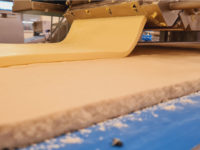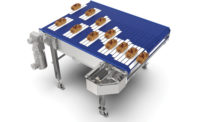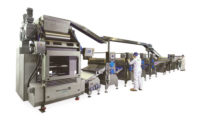Cleanability, flexibility, remote support top interests for extruder customers
Extruder customers aim to keep up with consumer trends.

Snack and bakery companies looking at new or improve extrusion equipment to create puffed and popped snacks, bakery items like nutrition bars, and other types of SKUs have features and benefits like cleanability, flexibility, and remote support high on their list of considerations, according to companies that make extrusion equipment.
Features in demand
No matter what size line customers are in the market for, they want a smart design with plenty of flexibility, says Gilles Maller, vice president sales & international, Clextral, Firminy, France. “Between the extruder and the dryer, they want to be able to include equipment to make co-extruded products and also bread snacks,” he says. “They want to be able to adapt the line with flexibility, integrated controls, and the ability to control perfectly those transition periods.”
Reliability and remote support are other key attributes that customers of extrusion equipment want to know about, Maller says. “They want to make sure you become completely operator independent,” he says. “All lines can be connected to the [operations] center in the U.S., North America, Asia, or Europe. Remote support has been important during the pandemic.”
Cleanability has been a consistent request from customers of Handtmann Inc., Lake Forest, IL, according to Ken Hagedorn, vice president, sales and marketing. “That’s really important,” he says. “You have to have really good sanitation standards. The Handtmann machines are built to comparable USDA washdown specs to those used in the meat industry.”
Customers also are looking for solid weight control that’s accurate and guards against damage to the system, Hagedorn adds. “In the long term, it’s an easier machine for maintenance, and it’s less costly,” he says. “When the cleanability is good, your changeover is quick—it will take five to 10 minutes to make a changeover from product to product.”
Bühler Group, Plymouth, MN, hasn’t seen major changes in customer requests, mostly tweaks to technical details, says Mike Shaw, sales account manager – snacks and cereals. “Extrusion has not changed in years. It’s the same machines,” he says. “The base machine is going to have the same functionality. People are trying different types of ingredients.”
Clextral has noticed snack and bakery companies more often wanting to make both savory and sweet products on the same extruder. “Being able to do both products on the same line requires some very strong flexibility on the extruder and on the dryer,” he says. “Flexibilty has always been a key, but it’s even more important today. We run with more and more complex and different recipes. You have the trend we started to see a while ago with proteins in the snacks. You want easy to clean, you want to be able to access everything in the machine and be clean everything as you go to a recipe with plant-based proteins.”
Maller hasn’t noticed any particular trend in the shapes or designs of extruded snacks. “We have a library of shapes that seems to satisfy our customers,” he says. “Very complex shapes are more to please one customer—I don’t see a very specific trend on that.”
Ingredients get more varied all the time, which adds to the need for ease of cleaning-in-place, Maller says. “Every single part of the tank should be very easy to clean, to make sure that when you go from a batch with chocolate to a batch with cheese, you have zero contamination,” he says. “That’s a very strong constraint, especially in the premium market, where customers want to ensure that the hygiene and sanitation is very strong.”
Hagedorn has noticed that protein bites of various types seem to be gaining popularity rapidly. “I don’t know the formulas, but something where they’re healthier, and it’s not a lot of sugar and things like that,” he says. “Whatever materials they use, whether it’s some type of vegetable additive, those seem to be taking off. It’s a direction a lot of people are going. More people are looking at co-extruded snacks. Instead of plain mozzarella sticks they want a filled mozzarella stick. Instead of plain, they want filled bread sticks.”
Advanced extruders
Clextral has introduced new or improved extruders in a couple of categories, Maller says. The newest version of the Evolum extruder incorporate features to promote a hygienic design, such as a stainless steel frame, that he says represents an “incremental innovation on the existing equipment.”
Secondly, Maller says, the company has rolled out a premium series of dryers called Evolum Plus. “It’s a premium dryer with improved hygienic design,” he says. “You can have a complete washdown of the dryer—everything can be power washed and cleaned, like that. That’s key to avoid cross-contamination. When people work with new materials, like proteins, you need a completely sanitized environment.” The machine allows for clean-in-place of the belt, after processing a sticky product, for example, he adds.
Clextral endeavors to provide those sanitation features while still making a good product with the right texture, Maller says. “That’s part of the know-how we have in-house,” he says. “We tweak recipes to incorporate new ingredients. We control the extrusion and drying parameters to adapt processing and make products that customers like. Some customers opt for the smaller line, like 1,000 pounds per hour, because they don’t have huge batches, and they want some flexibility on their lines. At the same time, we can deliver a line with a 5,000-pounds-per-hour output.”
Handtmann’s extruder is focused on snacks that incorporate doughs, cheeses and meats, like a filled mozzarella stick or a filled piece of dough, Hagedorn says. “Handtmann does a lot of things like Slim Jim’s. Those are the types of snacks we do,” he says. “We could do a co-extruded pizza bite, with dough on the outside and a blend of sauce and cheese on the inside. We’re constantly coming up with tools for better forming.”
Krüger & Salecker Maschinenbau GmbH & Co., Bad Schwartau, Germany, has a long history of providing forming machinery for such products as cereal bars and puffed, popped, and extruded cereals, while nutrition bars also have become an important focus. Consumer trends have prompted the company to reduce sugar and binders as much as possible, cutting 30 percent or more sugar content using K&S’ G-Technology series, which also has resulted in significant binder reduction. The company’s GFT 0200-0600 and GTW 0400-1000 machines, made of teflonized stainless steel and aluminum, also provide for easy tool changes, gentle and precise shaping, and an integrated feeding system for medium and large capacities, K&S says.
What’s next?
Looking into his crystal ball, Shaw believes that snacks incorporating meat analogues—not just veggie burgers but pulled pork, chicken breast, and other high-protein alt-meats—are “going through the roof.” He believes that “something that could be tested with our extruders is going to be a beef-jerky-type product that’s plant-based… It would be high protein, it could potentially be filled with sundried tomatoes, maybe with a spicy exterior. That could be made on a twin-screw.”
Hagedorn also predicts a growth in vegetable-based protein snacks. “The fake Chicken McNuggets—you can count them as a snack,” he says. “We also still see a huge rise in gluten-free baked products—if you’re looking at brownie bites or shortbread bites, that maybe have a topping on them, those things are on the increase. Because gluten-free is growing so fast, manufacturers that are smaller to medium-sized, they can’t keep up anymore.”
Maller expects “more of the same” in the extrusion category, although with a growing emphasis on protein-oriented snacks, especially plant-based. “That’s going to irrigate more and more markets,” he says. “You’re going to see that trickling down into snack categories more and more. In Europe and North America, they want to have an organic product. That’s part of their way of life—proteins, organic, good-for-you products.” But, he adds, “There will still be big lines to make Cheetos-type products because people love them.”
Looking for a reprint of this article?
From high-res PDFs to custom plaques, order your copy today!







